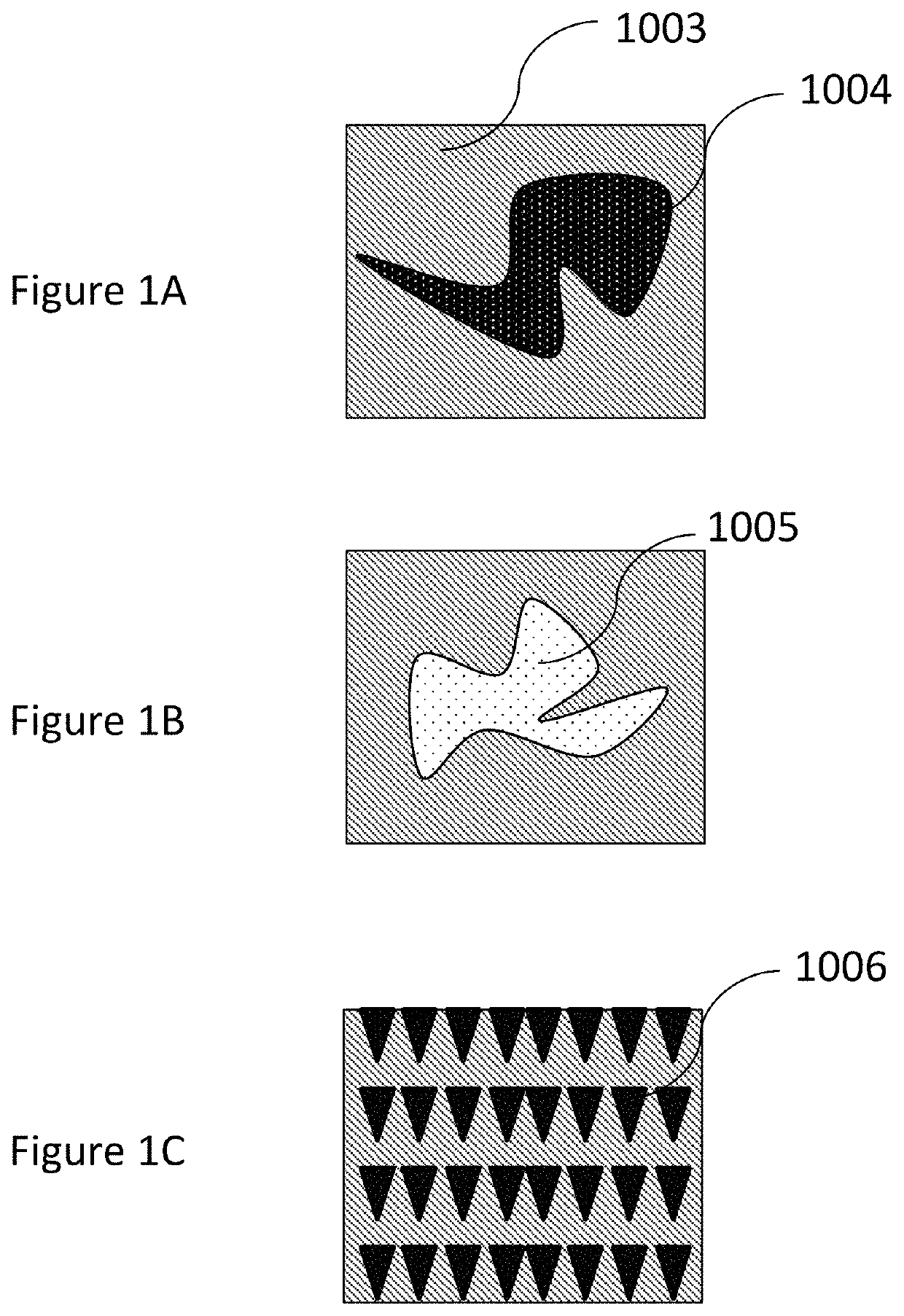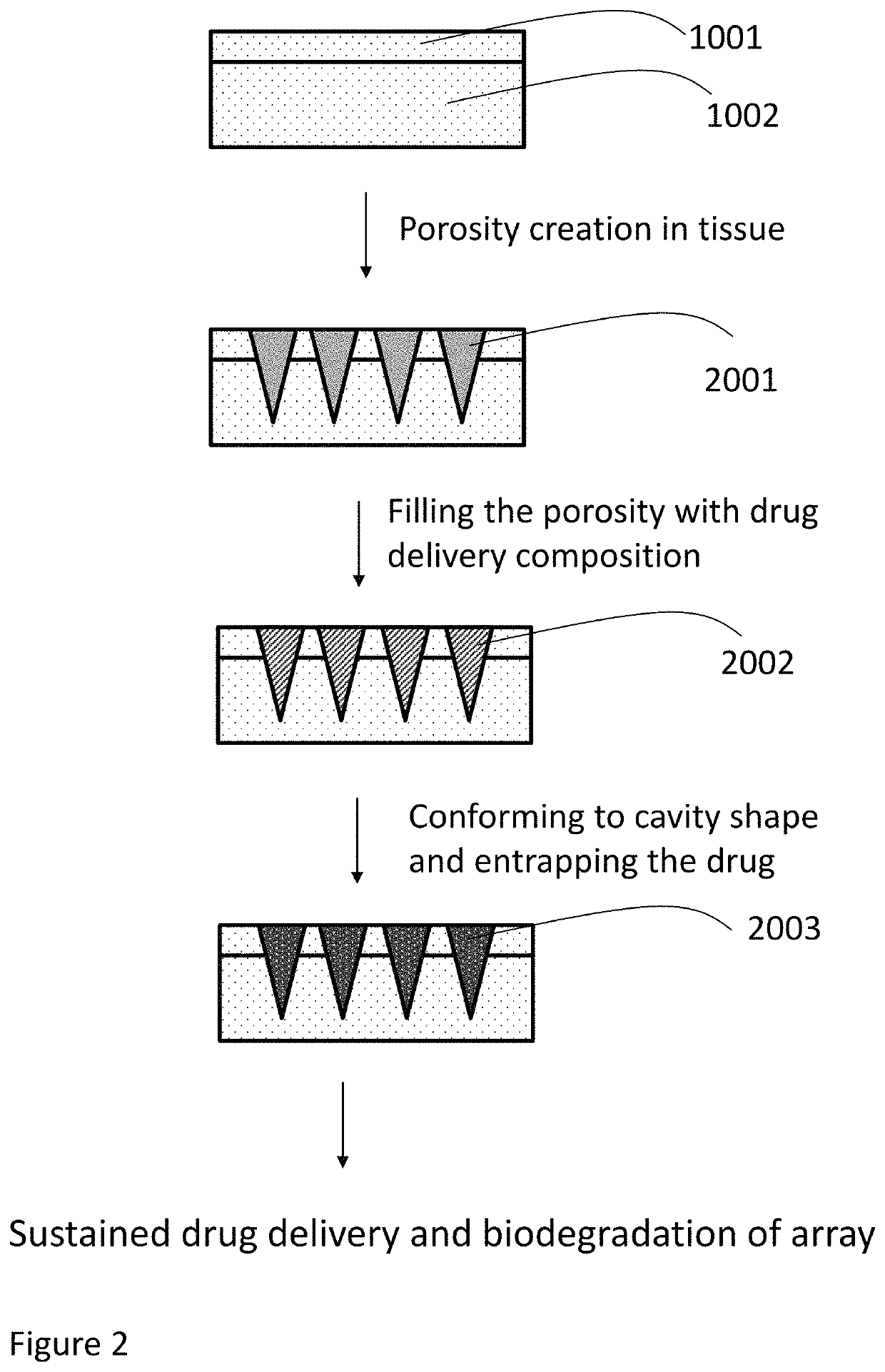Methods, compositions, and devices for drug/live cell microarrays
a technology of live cell microarrays and compositions, applied in the direction of aerosol delivery, inorganic non-active ingredients, prosthesis, etc., can solve the problems of limited use of hard/solid materials, inability to use soft materials, and inability to be considered a reliable method of managing anemia, etc., to achieve efficient insulin delivery
- Summary
- Abstract
- Description
- Claims
- Application Information
AI Technical Summary
Benefits of technology
Problems solved by technology
Method used
Image
Examples
example 1
[0362]Preparation of In Situ Implant for Sustained Drug Delivery Using Biodegradable Filler
[0363]Use of Filler in Injectable Polymer Solution Systems
[0364]Use of magnesium carbonate as an exemplary biodegradable inorganic filler. 100.2 mg PDLG 5002 polymer is dissolved in 1.0 ml DMSO. 10 microliters of methylene blue stock solution (10 mg methylene blue in 2 ml DMSO) is added to the polymer solution as a colorant.
[0365]Infusion solutions are prepared using the following method: 15.2 mg bupivacaine hydrochloride and 0.50 ml polymer solution are mixed until drug is completely dissolved. 50 mg magnesium carbonate powder (fine powder sieved to collect fraction below 300 microns in size) is added as a biocompatible and biodegradable filler in the drug solution and the mixture is vigorously vortexed for 5 minutes. The magnesium carbonate suspension is infused / tattooed using an oscillating needle in 1 cm square area of sheep skin tissue. Excess solution from the tattooed surface is wiped o...
example 2-a
[0368]Preparation of In Situ Implant Using Biodegradable Polymeric Particulate Filler.
[0369]Use of polymeric particulate filler in a biodegradable polymer solution in water miscible solvent.
[0370]Use of polyglycolic acid (PGA) microparticles as an exemplary biodegradable polymeric filler in a biodegradable polymer solution in water miscible solvent.
[0371]200.1 mg PDLG 5002, 2.0 ml polyethylene glycol dimethyl ether and 20 microliter methylene blue stock solution (as a colorant) are mixed until polymer is completely soluble in the solvent. 15.1 mg bupivacaine base and 0.5 ml polymer solution as above is mixed until complete solution. The solution is sterile filtered and is then mixed with 20 mg sterile PGA microcylinders (150 microns in diameter and 200 microns length), prepared by cutting the fibers / filaments / threads. The PGA particles are insoluble in the polymer solution and form suspension upon vigorous mixing. 0.3 ml of the suspension is injected into chicken leg muscle using st...
example 2-b
[0374]Use of polymeric particulate filler in a biodegradable polymer solution in water miscible solvent.
[0375]Use of polyvinyl alcohol or protein (collagen or albumin) microparticles.
[0376]50.4 mg PDLG 5002, 0.5 ml polyethylene glycol dimethyl ether (PEGDME) as a polymer solvent 5.0 microliter methylene blue solution as a colorant (10 mg methylene blue dissolved in 2.0 ml DMSO) are mixed until polymer is completely dissolved. 7.5 mg Bupivacaine base (approximately 30 percent of polymer weight) and 0.25 mg polyvinyl alcohol (PVA) powder as a biodegradable filler (sieved, PVA particle size less than 300 microns) are added to 0.25 ml polymer solution as above. The filler weight is approximately same as PDLG polymer weight (1:1). The PVA powder is insoluble in polymer solution but the drug Bupivacaine base is soluble. The suspension is infused in the bovine pericardium tissue in 1 square centimeter area using oscillating needle to form a drug delivery array / implant. The infused polymer ...
PUM
| Property | Measurement | Unit |
|---|---|---|
| depth | aaaaa | aaaaa |
| fluorescent | aaaaa | aaaaa |
| biocompatible | aaaaa | aaaaa |
Abstract
Description
Claims
Application Information
 Login to View More
Login to View More - R&D
- Intellectual Property
- Life Sciences
- Materials
- Tech Scout
- Unparalleled Data Quality
- Higher Quality Content
- 60% Fewer Hallucinations
Browse by: Latest US Patents, China's latest patents, Technical Efficacy Thesaurus, Application Domain, Technology Topic, Popular Technical Reports.
© 2025 PatSnap. All rights reserved.Legal|Privacy policy|Modern Slavery Act Transparency Statement|Sitemap|About US| Contact US: help@patsnap.com



